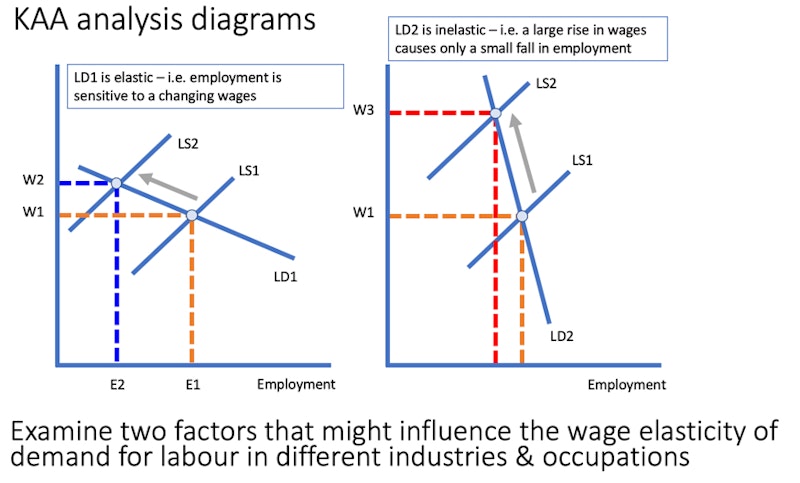Topic Videos
Elasticity of Labour Demand - Analysis and Evaluation Paragraphs
- Level:
- A-Level, IB
- Board:
- AQA, Edexcel, OCR, IB, Eduqas, WJEC
Last updated 14 Mar 2019
Here is a worked example of analysis and evaluation paragraphs to this question: Examine two factors that might influence the wage elasticity of demand for labour in different industries & occupations.
KAA Point 1:
Wage elasticity of demand for labour measures the sensitivityof employment to a change in wage rates. The formula is % change in labour demand / % change in wages. One factor that can make labour demand wage elastic is when labour costs are a high % of total operating costs e.g. in labour-intensive jobs such as catering and tourism. Firms may choose to operate with temporary job contracts and a smaller core of permanent staff in order to control the wage bill and give them more flexibility in the event of changes in market demand for their products.
Evaluation Point 1:
However much depends on the market structure in which a business is operating in. Consider a firm with market power making supernormal profits and where consumer demand has a low price elasticity of demand. Even if wage costs rise and the wage bill grows substantially – for example following an increase in the living wage – then the firm might be able to pass on the increase in variable costs to final consumers through higher prices. In the building industry for example, this might depend on whether there is a fixed-price contract to complete.

KAA Point 2:
A second factor affecting wage elasticity of demand for labour is the ease and cost of factor substitution. If a firm finds it both difficult and also costly to substitute capital inputs for labour, then demand will tend to be wage inelastic (as shown in my diagram). An example might be the heavy fixed cost required for a warehouse firm to install the infrastructure for robots as part of automation. In the short run, it might be difficult to justify a significant increase in capital intensity, instead the focus might be on trying to improve labour productivity if wages rise.
Evaluation Point 2:
However, rapid advances in robotics and artificial intelligences are reducing the time lag between a decision to replace some labour inputs with cutting-edge capital technologies. Businesses can also now lease the required technology rather than meet the full purchase cost. If this is the case, then labour demand may become more sensitive to changes in wages over time. For example, higher minimum wages might accelerate the use of scanning technologies in supermarkets and cameras and sensors could replace security guards.
You might also like

Automation a factor behind falling real wages for millions
19th October 2014
Minimum Wages - Analysis of Impact (Labour Markets)
Topic Videos
Minimum Wages - Evaluation (Labour Markets)
Topic Videos

Must Watch Revision Videos on Labour Markets
1st June 2018

Singapore's e-sports training academies
20th November 2017

The Economics of Superstars
12th September 2018

Inside the Amazon Warehouse - Monopsony under Scrutiny
11th November 2018

Labour shortages - is market power shifting to workers?
30th August 2021